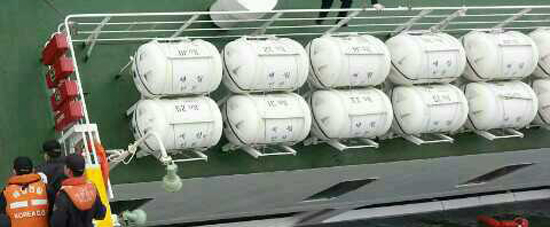Ferry got ‘good’ safety grades in Feb. inspection

Automatically inflatable rafts on the deck of the ferry Sewol did not function properly, according to the Coast Guard. Provided by Coast Guard
The ferry that capsized off the southwest of Korea on Wednesday underwent a safety check in February jointly conducted by the Coast Guard, the Korean Register of Shipping and three other private and state-run agencies, according to reports obtained by Ha Tae-kyung, a lawmaker for the Saenuri Party.
In the test, Sewol received “good” marks on the management of its lifeboats.
But during the sinking, only one of 46 boats on the ferry’s upper deck operated properly. Each lifeboat was capable of carrying 25 people. If they all worked, the calamity could have been avoided, analysts said.
It’s obvious now that the safety check of the lifeboats was cursory. “If we look at the documents concerning the lifeboats, what they checked was the number of lifeboats and their capacity,” Ha said.
The Coast Guard confirmed yesterday that many lifeboats, which were automatically inflatable rafts, didn’t function properly while the ship was sinking, but didn’t specify why they were not automatically launched. Some local media reports allege that the boats were chained up. Broadcasting company KBS quoted one survivor as saying that the boats and the ropes around them were covered in thick paint that glued them together.
“There were no comments,” Ha said. “The Korean Register of Shipping said it’s customary that lifeboats pass the test. Now we can’t trust the results of safety inspections.”
The Korean Register of Shipping, the country’s only ship classification society, is devoted to promoting safety standards and safety inspections.
It maintained that February’s test was carried out in a proper way. It claims the Sewol’s lifeboats couldn’t be launched due to high waves.
But the Korean Register of Shipping has refused to release documentation about the February test, saying it would increase confusion.
Although the safety check found deficiencies in watertight doors and emergency lights, the Incheon Coast Guard office, which was involved in the February test, said it didn’t follow up on the problems raised because it is not in charge of such technical issues.
Safety equipment like watertight doors is critical in emergencies. The doors are designed to keep water out and maintain the ship’s stability if it is swamped with water.
“We asked the Korea Register of Shipping, Korea Shipping Association and Korea Ship Safety Technology Authority to look into the case,” said a representative of the Coast Guard.
The Korea Shipping Association cannot make independent investigations of ships. Its members are shipping companies and manufacturers.
The February test also revealed that the crew of the Sewol were not adequately trained to use emergency alarms.
BY PARK EUN-JEE [ejpark@joongang.co.kr]










with the Korea JoongAng Daily
To write comments, please log in to one of the accounts.
Standards Board Policy (0/250자)